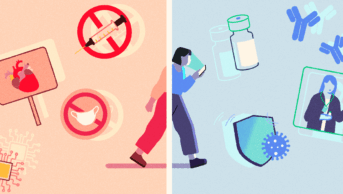Eye colour is far more than simply a cosmetic issue — it has a number of health implications. Blue-eyed individuals are more prone to macular degeneration, but less likely to suffer from cataracts, than their darker-eyed contemporaries. And people with darker eyes are considered to be more trustworthy, are less likely to abuse alcohol and have faster reaction times.
Everybody had brown eyes about 10,000 years ago, until a mutation arose in the OCA2 gene that disrupted melanin production in the iris of someone living in the Black Sea region. They became the first blue-eyed human and everyone with blue eyes is descended from that one individual.
Individuals with blue and green eyes, particularly those of British, Scandinavian or German descent, are more likely to develop macular degeneration. This is because their irises contain less melanin to shield the eye from blue light. But people with brown eyes are up to 2.5 times more likely to develop certain types of cataract. This could be at least partly because darker coloured eyes absorb more light, but other factors may be at play.
Darker eyes are thought to be a symbol of trustworthiness, but experiments have shown that is the different facial morphology that accompanies darker eyes, rather than eye colour itself, that is the key. When subjects were shown photographs of brown and blue-eyed people, they rated the brown-eyed faces as more trustworthy, although this effect only applied to male faces. But when the eyes were recoloured, eye colour had no effect on perceived trustworthiness. The broader chins, larger mouths and noses, and closer, more prominent eyebrows of the dark-eyed males held the key.
Dark-eyed individuals have faster reaction times in response to a simple one-off stimulus that does not require an accurate response, but those with blue eyes are likely to be better at tasks requiring longer-term thinking. People with darker eyes exhibit more physiological arousal and sensitivity to some medications, and their greater sensitivity to alcohol could make them less likely to drink the large quantities necessary to become dependent.
Suggested theories for links between eye colour and behaviour include that eye darkness is related to the speed of neural transmission. The amount of melanin in the iris and central nervous system is related embryologically, and melanin sheaths covering neuronal axons act as an insulator, allowing faster nerve impulse conduction, explaining faster reactions among the darker-eyed. Another theory is that endocrine function responds to light of varying wavelengths and melanin in the iris blocks blue light while allowing more red light into the eye.


